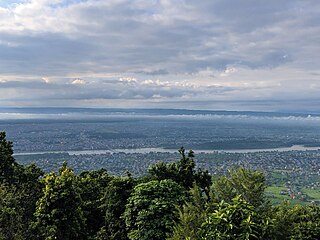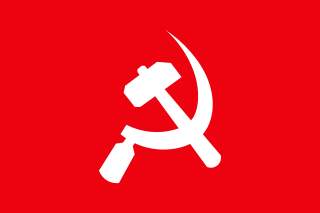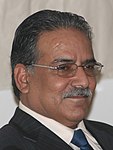
The politics of Nepal functions within the framework of a parliamentary republic with a multi-party system. Executive power is exercised by the Prime Minister and their cabinet, while legislative power is vested in the Parliament.

The Nepali Congress is a social democratic political party in Nepal and the largest party in the country. The party has 870,106 members as of the party's 14th general convention in December 2021, making it the largest party by membership in Nepal. In June 2023, the party started online membership since the emergence of youth leaders in vital posts to attract youths to the party. The party is led by former prime minister, Sher Bahadur Deuba since the party's thirteenth general convention in 2016. The party won 89 seats in the 2022 general election and is currently the largest parliamentary group in the House of Representatives.

The Communist Party of Nepal (Maoist Centre) (Nepali: नेपाल कम्युनिस्ट पार्टी (माओवादी केन्द्र), romanized: Nēpāla Kamyunisṭa Pārṭī (Mā'ōvādī Kēndra)), abbreviated CPN (Maoist Centre) or CPN (MC), is the third largest political party in Nepal and a member party of Samajbadi Morcha. It was founded in 1994 after breaking away from the Communist Party of Nepal (Unity Centre). The party launched an armed struggle in 1996 against the Nepalese government. In 2006, the party formally joined mainstream politics after signing a peace agreement following the 2006 Nepalese revolution.

The Communist Party of Nepal (Unified Marxist–Leninist) (Nepali: नेपाल कम्युनिष्ट पार्टी (एकीकृत मार्क्सवादी-लेनिनवादी), romanized: nēpāl kamyuniṣṭ pārṭī (ēkīkṛt mārksavādī-lēninavādī); abbr. CPN (UML)) is a communist political party in Nepal. The party emerged as one of the major parties in Nepal after the end of the Panchayat era.

Bharatpur is a city in south central Nepal. It is the third most populous city of Nepal after Kathmandu and Pokhara with 369,377 inhabitants in 2021. It is also the second largest metropolitan city in Nepal by area. It is the district headquarter of the Chitwan District.

Constituent Assembly elections were held in Nepal on 10 April 2008, having been postponed from earlier dates of 7 June 2007 and 22 November 2007. The Constituent Assembly was planned to draft a new constitution and therefore decide, amongst other things, on the issue of federalism. The number of eligible voters was around 17.5 million. The Constituent Assembly was originally set to have a term of two years.
Young Communist League, Nepal is the youth wing of Communist Party of Nepal. The president of YCL is Subodhraj Serpali and the general secretary of YCL is Ganesh Shahi. The Young Communist League (YCL) was formed by the CPN–Maoist at some point during the 'people's war' to support the revolution. Ganeshman Pun, Former chairman of the YCL, has stated that the League was reactivated in November 2006. According to him, the YCL "is a fusion of the Party's military and political character, and it is composed of PLA members who have an interest in politics." As the party's youth wing, its role is to "organise youth, be involved in events, conduct political awareness, and take part in development work as volunteers." Once the CPN-Maoist was proscribed, the YCL was also forced underground. After the April 2006 Jana Andolan and the subsequent over-ground role of the insurgents, the CPN-Maoist revived the YCL.

The Communist Party of Nepal (Revolutionary Maoist) (Nepali: नेपाल कम्युनिष्ट पार्टी (क्रान्तिकारी माओवादी)), abbreviated CPN (RM), was a communist party in Nepal. It was founded in June 2012 by the then vice-chairman of Unified Communist Party of Nepal (Maoist), Mohan Baidya after splitting from the party.
Constituent Assembly elections were held in Nepal on 19 November 2013. The vote was repeatedly delayed, having previously been planned for 22 November 2012 following the dissolution of the 1st Constituent Assembly on 27 May 2012, but it was put off by the election commission. The Nepali Congress emerged as the largest party in the 2nd Nepalese Constituent Assembly, winning 196 of the 575 elected seats.

Municipal election for Kathmandu, capital of Nepal was held on May 14, 2017, for the position of Mayor, a Deputy Mayor, 32 Ward Chairmen and Ward Members. All positions are for a period of 5 years. A secondary election is to be held for municipal executive which will elect 5 women from the elected ward members and 3 members who must be from the Dalit and minority community. The electorate for this election will the 159 members chosen direct election.
On 26 May 2019, three bombs exploded in Kathmandu, Nepal, killing four and injuring seven. The first blast happened in a house in the Ghattekulo residential area killing one. The second blast took place at a hairdresser's premises in Sukedhara, killing three. The third blast went off in Thankot area of Kathmandu, injuring two.

Communism in Nepal traces its roots back to the pro-democracy movement of 1951, and the subsequent overthrow of the autocratic Rana regime and the establishment of democracy in Nepal. The communist movement in Nepal has split into factions multiple times and multiple factions have come together into a single fold at times as well. It has a history of getting banned from open political discourse, as well as multiple instances of embracing guerrilla insurgency, most notably, the Maoist insurgency in the 1990s and early 2000s that led to the Nepalese Civil War, claiming at least 17,000 lives.

Netra Bikram Chand (Nepali: नेत्र विक्रम चन्द Known by Biplav Si is a Nepalese Maoist politician and rebellion leader. He together with fellow Maoist leader Ram Bahadur Thapa, was the two main militia commanders of Prachanda in the Nepalese Civil War. He separated from CPN Maoist and became the chairperson of Communist Party of Nepal in 2014. He waged an armed struggle against the government until 2020 when a peace deal was signed.
National Assembly elections were held in Nepal on 26 January 2022 in order to elect 19 of the 20 retiring Class II members of the National Assembly, the upper house of the Federal Parliament of Nepal. Members of the National Assembly are elected through indirect ballot and serve six year terms with one third of the members retiring every two years. However, the retiring members served only four year terms due to the entire house being elected in 2018 when a lottery was held to determine two, four and six year term members.

The 2022 Nepalese local elections were held on 13 May 2022 in 6 metropolitan cities, 11 sub-metropolitan cities, 276 municipalities and 460 rural municipalities. These were the second set of local-level elections to be held since the promulgation of the new constitution in 2015. From the local election result Nepali Congress has become the single largest party of Nepal followed by CPN (UML) and Maoist Centre.
Ichchhakamna is an only rural council located in Chitwan District in Bagmati Province of Nepal.
The Scientific Socialist Communist Party, Nepal is a political party in Nepal. The party was founded on 5 May 2018, the 200th birth centenary of Karl Marx. The party founder Aahuti had previously been a leader of Janamorcha Nepal and later the Communist Party of Nepal, and had rebelled against the unity process of CPN(Maoist Centre) with the CPN(UML) in late 2017. Ahuti formed a 51-member 'Ideological, Political and Organizational Mobilization Committee-2075' for building the new party. Balaram Timilsina, Rajeshwari Subedi, Jagrat Rayamajhi and Dhruv Parajuli were some of the former Maoist leaders that joined Ahuti's party building effort.

Municipal election for Kathmandu took place on 13 May 2022, with all 162 positions up for election across 32 wards. The electorate elected a mayor, a deputy mayor, 32 ward chairs and 128 ward members. An indirect election will also be held to elect five female members and an additional three female members from the Dalit and minority community to the municipal executive.
Municipal election for Bharatpur took place on 13 May 2022, with all 147 positions up for election across 29 wards. The electorate elected a mayor, a deputy mayor, 29 ward chairs and 116 ward members. An indirect election will also be held to elect five female members and an additional three female members from the Dalit and minority community to the municipal executive.
Municipal election for Jitpursimara took place on 13 May 2022, with all 122 positions up for election across 24 wards. The electorate elected a mayor, a deputy mayor, 24 ward chairs and 96 ward members. An indirect election will also be held to elect five female members and an additional three female members from the Dalit and minority community to the municipal executive.



















